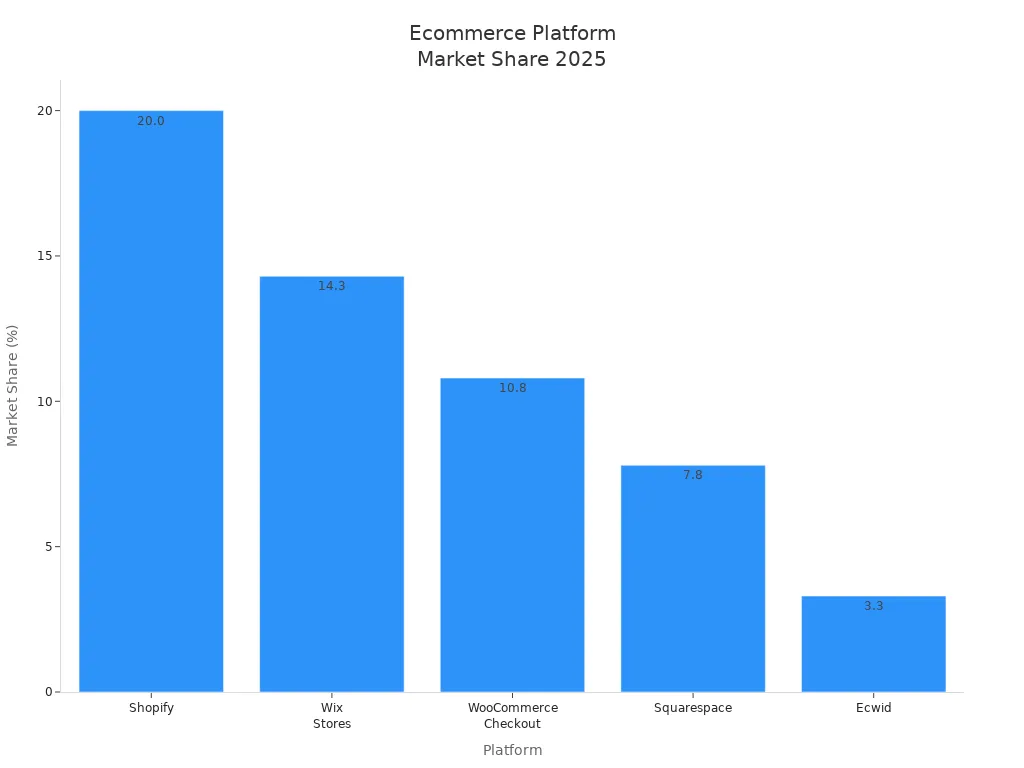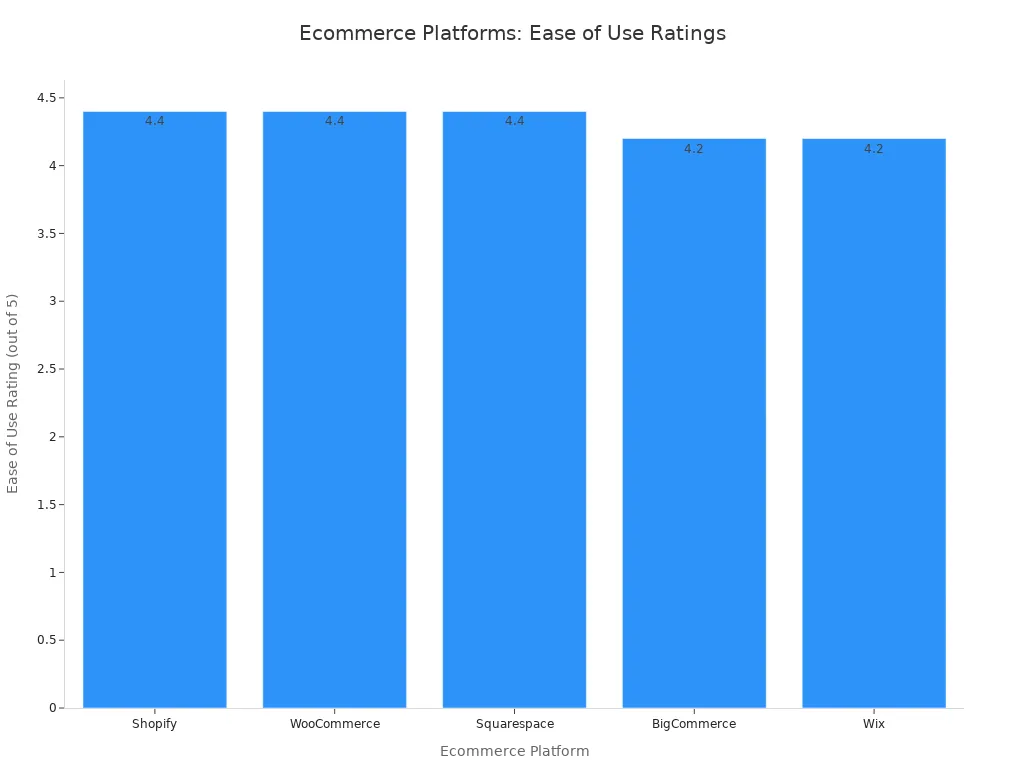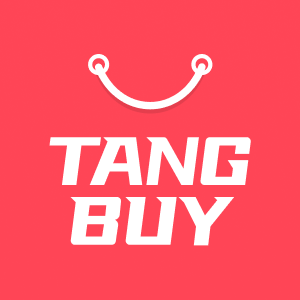Shopify Alternatives to Grow Your Online Business in 2025

You have more options than ever for ecommerce platforms. In 2025, Shopify is the leader with a 20% global market share. But many Shopify Alternatives are popular for other reasons. Look at these numbers:
Platform | Approximate Websites (millions) | Market Share (%) |
|---|---|---|
Shopify | ~4.8 | 20.0 |
Wix Stores | ~3.4 | 14.3 |
WooCommerce Checkout | ~2.6 | 10.8 |
Squarespace | ~1.9 | 7.8 |
Ecwid | ~0.8 | 3.3 |
Others | N/A | Remaining share |

Why do many shop owners pick Shopify Alternatives? You might want to pay less money. You may want easier ways to change your shop. Some platforms have features that fit your business better. Some people want more control. Others want help to grow their shop. Different platforms work for different needs.
Key Takeaways
Many Shopify alternatives have special features for different needs and budgets. You should think about your shop size, product type, and future plans when picking a platform. Costs can be very different. Look out for extra fees like apps or payment processing. It is important that the platform is easy to use. Platforms like Wix, Squarespace, and Shopify are good for beginners. Scalability is important. Choose a platform that can grow with your business and handle more sales easily. Customisation choices go from simple templates to full code control for unique shops. Good customer support can help you save time and avoid stress. Shopify and BigCommerce give 24/7 help. Try free trials to see which platform fits you best before you decide.
Shopify Alternatives Overview


Comparison Table
There are many choices for online shop platforms. It can feel confusing to pick one. This table shows some popular Shopify Alternatives in 2025. It points out what makes each platform special. It also says who might like each one best.
Platform | Unique Features & Best For |
|---|---|
Wix | Drag-and-drop builder, many templates, strong SEO tools. Great for small businesses. |
BigCommerce | Advanced customisation, multi-channel selling, powerful marketing. Fits all business sizes. |
Squarespace | Beautiful templates, easy inventory, secure payments. Perfect for creative entrepreneurs. |
PrestaShop | Open-source, high customisation, full control. Best for those who want autonomy. |
Zoho Commerce | All-in-one management, CRM integration. Good for businesses using Zoho tools. |
eComchain | Cloud-based, B2B and B2C, scalable. Designed for B2B e-commerce. |
Big Cartel | Simple, affordable, focused on artists and makers. |
Ecwid | Integrates with existing sites, mobile support, quick setup. |
Sellfy | Made for digital products, file hosting, easy payments. |
Weebly | Drag-and-drop, custom templates, marketing tools. Good for small businesses. |
Magento | Open-source, highly customisable, multi-store support. Ideal for large enterprises. |
PinnacleCart | Drag-and-drop, advanced product management, strong SEO. Scalable for growing shops. |
Simvoly | Website builder, e-commerce, user-friendly, nice templates. Good for small businesses. |
Square Online | Easy setup, integrates with Square payments. |
💡 Tip: Think about how big your shop is. Think about what you want to sell. Decide how much control you need. This will help you choose the right platform.
Top Picks
You may want to know which Shopify Alternatives are best for you. Here are some good choices for 2025:
Wix: This is a great all-in-one choice. It has many features and is simple to use.
Squarespace: If you offer services, you will like the scheduling tools.
Hostinger: Pick this if you want to save money.
GoDaddy: This is good for beginners and has strong social marketing.
Big Cartel: Artists and makers like this because it is easy and cheap.
Ecwid: You can add this to your website or social page to sell fast.
There are lots of Shopify Alternatives you can try. Each one has something different to offer. Take your time and pick what works best for your shop.
Choosing an Ecommerce Platform

Cost
You want to keep your costs low, but you also want a platform that helps your business grow. Every ecommerce platform has its own way of charging you. Some charge a monthly fee. Others take a cut from each sale. A few let you start for free, but you might pay more as your shop gets bigger.
Here’s a quick look at how some popular platforms compare:
Platform | Base Cost Structure | Extra Fees and Notes |
|---|---|---|
WooCommerce | Free base; pay for hosting and domain | Costs change with hosting; total price can vary |
$5 to $2,300/month | Extra fees if you don’t use Shopify Payments; apps and themes can add to the cost | |
Wix | Free plan (limited); business plans $36–$159 | Some features need higher-tier plans |
Volusion | $39 to $299/month | Payment processing and apps cost extra |
Price goes up with sales volume | Higher price if you sell more; built for scaling | |
Squarespace | Pricing not detailed | Focus on design and ease; ecommerce included, but exact costs not listed |
You should always check what’s included in the price. Some platforms look cheap at first, but you might pay more for apps, themes, or payment processing. Think about your budget now and how it might change as your shop grows.
💡 Tip: Look for transparent pricing. Make sure you know what you’ll pay each month and what could make your costs go up.
Scalability
Your business might be small today, but you want it to grow. Scalability means your platform can handle more products, more customers, and more orders without slowing down or breaking.
Modern ecommerce platforms help you scale in smart ways:
They automate tasks like order processing and stock updates, so you save time and avoid mistakes.
You can sell on many channels—your website, Amazon, social media—all from one place.
Platforms connect with tools that manage your stock, orders, and customer data in real time.
You get reports and analytics to help you make better decisions and plan for growth.
Some platforms let you add new features as you need them, so you don’t outgrow your shop.
If you want to grow fast, pick a platform that offers automation, multi-channel selling, and strong analytics. This way, you can focus on your customers instead of fixing tech problems.
Ease of Use
You don’t want to spend hours learning how to use your shop. The best platforms make it easy to set up, add products, and manage orders—even if you’re not a tech expert.
Here’s how some top platforms rate for ease of use:
Platform | Best For | Price Range | Ease of Use (G2 Rating) | Key Features |
|---|---|---|---|---|
Shopify | Most users | $39–$399 | 4.4/5 | Simple dashboard, great support, easy for anyone |
WooCommerce | Tech-savvy users | Free + add-ons | 4.4/5 | Customisable, but needs more tech skills |
BigCommerce | Growing businesses | $29–$299 | 4.2/5 | Powerful, but a bit more complex |
Wix | Beginners and side hustlers | $29–$159 | 4.2/5 | Drag-and-drop, easy to start |
Squarespace | Creatives and artists | $27–$65 | 4.4/5 | User-friendly, great for design |

If you want a smooth start, Shopify, Wix, and Squarespace are all easy to use. WooCommerce gives you more control, but you’ll need some tech skills. Always try a demo or free trial before you decide.
👍 Note: The easier your platform is to use, the more time you’ll have to focus on your products and customers.
Customisation
You want your shop to look different from others. Customisation lets you change how your shop looks and works. Some platforms give you more freedom than others. If you want to change everything, try open-source options like WooCommerce or PrestaShop. These let you control every part, from design to checkout. You can add new features, change layouts, and edit the code if you know how.
Here’s a quick look at how some top platforms compare for customisation:
Platform | Customisation Level & Features |
|---|---|
WooCommerce | Limitless changes, open-source, works with WordPress, many extensions, full hosting control |
BigCommerce | Drag-and-drop builder, free themes, good for non-coders, more flexible than many competitors |
Adobe Commerce | Advanced features, highly customisable, needs technical skills, cloud or self-hosted options |
PrestaShop | Open-source, flexible, budget-friendly, full control over layout and function |
Deep customisation, access to code, great for complex B2B shops and large catalogues |
If you want something easy, Wix or BigCommerce have drag-and-drop tools. You can pick a template and change it without using code. For full control, WooCommerce and Miva eCommerce are good choices. They work well for shops with special needs or lots of products.
🛠️ Tip: Think about how much you want to change. If you want your shop to be unique, choose a platform with deep customisation.
Integrations
Integrations help your shop work with other tools. You might want to connect your shop to payment gateways, marketing apps, or stock management systems. Some platforms make this easy, but others need more work.
Let’s see how different types of platforms handle integrations:
Platform Type | Integration Options & Benefits |
|---|---|
SaaS (like Wix) | Built-in hosting, payments, CRM, backups. Easy to set up, less flexible. |
Headless | Front-end and back-end are separate. Easy to add social media or marketing. |
Open-Source | Full code access. Connect to anything, but you need tech skills. |
Enterprise | Handles payments, multi-store, ERP, mobile, and more. Great for big shops. |
Magento and PrestaShop both offer strong integration options. Magento has a huge marketplace and many developers. PrestaShop supports lots of apps and payment providers. If you want things simple, SaaS platforms do most of the work for you. If you need special tools or want to grow fast, open-source or enterprise platforms give you more options.
💡 Note: Make a list of the tools you use now. Check if your chosen platform connects with them before you decide.
Support

Good support helps you save time and avoid stress. You want help when you get stuck or have questions. Different platforms offer different types of support.
Here’s what you might find:
Platform | Support Type | Availability | Description |
|---|---|---|---|
Network Solutions | 24/7 | Always-on chat for setup and tech questions | |
Network Solutions | Business Consultants | Mon-Fri 8am-11pm ET | Experts help you find the right solutions |
Network Solutions | Phone Support | Mon-Fri 8am-11pm ET | Speak to someone for business advice |
Most big platforms have live chat, email, and phone support. Some even have expert consultants to guide you. If you use an open-source platform, you might use forums or pay for help.
👍 Tip: Pick a platform with support that fits your needs. If you work late or on weekends, 24/7 chat can really help.
In-Depth Shopify Alternatives

BigCommerce
Features
BigCommerce gives you many tools right away. You can manage lots of products and big sales easily. You can sell on your website, Amazon, eBay, and social media. The platform has advanced SEO tools and custom URLs. It supports many currencies. BigCommerce keeps your shop safe with strong security. It uses PCI DSS Level 1, SSL certificates, and multi-factor login. You can change your shop using HTML, CSS, and JavaScript if you want more control.
Pros and Cons
Here’s a simple look at how BigCommerce compares to Shopify:
Feature Category | BigCommerce Strengths | BigCommerce Weaknesses |
|---|---|---|
Scalability & Flexibility | Handles big catalogues, lots of sales, strong APIs, multi-channel selling, no transaction fees | Harder to learn, setup can be tricky, sales limits on cheaper plans |
Built-in Features | Many built-in features like advanced SEO tools, supports many currencies | Some SEO limits, may need third-party apps for extra features |
SEO & Marketing | Great built-in SEO tools, custom URLs, schema markup, AMP support, built-in CDN | SEO tools not as good as some other platforms |
Customisation | More built-in customisation, supports HTML/CSS/JS for design changes | Needs tech skills, can take time and cost more |
Security | Strong security with PCI DSS Level 1, SSL, MFA, regular checks | N/A |
Ease of Use | Setup and navigation are more complex | Harder to learn |
Transaction Fees | No transaction fees, no matter which payment gateway | N/A |
App Ecosystem | Fewer apps but more features built-in | Might need third-party apps for some advanced things |
💡 If you want lots of features and plan to grow fast, BigCommerce could be a good choice. Just know it is harder to learn.
Pricing
BigCommerce has different price levels. The cheapest plan is about £39 each month. If your sales go up, you might need a bigger plan. Bigger plans cost more but give you extra features. There are no transaction fees, even if you use other payment gateways. If you sell a lot, you might pay more, so watch your growth.
Best For
BigCommerce is best for growing shops that need strong features and want to sell in many places. If you have lots of products or expect many sales, this platform can handle it. You will like BigCommerce if you want more control and do not mind learning new things.
WooCommerce
Features
WooCommerce is a plugin for WordPress. You can turn any WordPress site into a shop. The main plugin is free, and you can add more features with extensions. You get full control over your shop’s look and how it works. WooCommerce lets you have unlimited products, flexible shipping, and many payment options. You can change everything, from checkout to the design. You own your data and can grow your shop as you want.
Pros and Cons
Here are the main points:
Pros:
Free to start with the main plugin.
Full control over your shop and data.
Huge library of plugins and themes.
Flexible hosting choices.
You can change every part of your shop.
Cons:
You must handle hosting, security, and updates.
Some features need paid plugins.
Setup and care take time and tech skills.
Costs can rise as you grow.
No built-in support—help comes from forums or paid experts.
👍 WooCommerce gives you freedom and flexibility. If you like to change things and want full control, this is a strong choice among Shopify Alternatives.
Pricing
WooCommerce itself is free. You pay for hosting, your domain, and any paid plugins or themes. Hosting can start at £5 per month, but bigger shops may pay much more. You control your costs, but you need to plan for extras like security, backups, and developer help if needed.
Best For
WooCommerce is good for shop owners who want full control and have some tech skills. It is great if you already use WordPress or want a unique shop. If you want to start small and grow at your own speed, WooCommerce lets you do that.
Wix
Features
Wix makes building your shop easy with drag-and-drop tools. You can pick from many templates and change them to fit your brand. Wix has built-in marketing tools, like SEO guides and abandoned cart recovery. You get safe hosting, SSL certificates, and automatic backups. The app market lets you add more features as you grow. You can sell physical or digital products, manage stock, and take payments online.
Pros and Cons
Here is a simple list to help you decide:
Advantages:
Nice, customisable templates.
Built-in marketing and SEO tools.
Cheap plans for small shops.
Good for beginners and creative people.
Disadvantages:
Not good for very big shops or high sales.
Fewer advanced features than Shopify or BigCommerce.
Payment processors charge transaction fees.
SEO tools are good but not the best.
You cannot change your template after you launch.
🛒 Wix is great if you want to start quickly and do not need lots of advanced features. It is one of the easiest Shopify Alternatives for new shop owners.
Pricing
Wix has a free plan, but you need a paid plan to take payments. Business plans start at about £15 per month and go up to £35 or more for extra features. All plans include hosting, SSL, and support. You may pay more if you add apps or need more space.
Best For
Wix is best for small businesses, creative people, and side hustlers. If you want a simple, cheap way to sell online and do not need advanced features, Wix is a great pick. You can make a professional shop without hiring a developer.
Squarespace
Features
You can make a nice online shop with Squarespace. There are over 185 free templates that look modern. The Fluid Engine editor lets you move things around easily. If you want, you can use custom CSS and JavaScript on higher plans. Squarespace lets you sell up to 10,000 products. Each product can have 250 variants. You can sell both physical and digital items. You can keep track of your stock and set up safe payments with Stripe, PayPal, or Square. The platform has built-in SEO tools and marketing features. You also get analytics to see how your shop is doing. You can send email campaigns and book appointments if you offer services. You get a 14-day free trial to try everything. Squarespace works well on mobile, so your shop looks good everywhere.
Pros and Cons
Pros | Cons |
|---|---|
Easy drag-and-drop editor | You can only have 10,000 products and 250 variants |
Over 185 free, stylish templates | No shipping rate calculator built in |
SEO and marketing tools included | Dropshipping support is limited |
You can sell digital and physical products | Only Stripe, PayPal, and Square for payments |
Appointment booking for service shops | Lower plans have transaction fees (up to 3% or 9% for subscriptions) |
Fast help guides and resources | No support for more than one currency |
14-day free trial | Not made for very big shops |
💡 If you want a shop that looks great and is easy to run, Squarespace is a good pick. You can focus on your brand and products, not on tech stuff.
Pricing
Squarespace makes prices simple. You can pick from these plans:
Plan Name | Monthly Price (2025) | Transaction Fees | Key Features |
|---|---|---|---|
Personal | $16 | N/A | Website only, no ecommerce |
Business | $23 | 3% per sale | Ecommerce, basic features |
Commerce Basic | $39 | None | No transaction fees, full shop features |
Commerce Advanced | $99 | None | Advanced analytics, subscriptions, abandoned cart |
Commerce Core | $36 | None | Best value for most shops |
You pay more for things like subscriptions and abandoned cart recovery. Lower plans have transaction fees, and selling subscriptions can cost up to 9%. You get a 14-day free trial to test before you buy.
Best For
Squarespace is great for small businesses and creative people who want a nice shop without coding. If you want to sell up to 10,000 products and care about design, this is a good choice. You get strong marketing tools and easy setup. It is not for very big or complex shops. Squarespace is one of the best Shopify Alternatives for design and ease of use.
Shift4Shop
Features
Shift4Shop gives you lots of ways to build your shop. You can change your shop’s look and features to match your brand. The platform has strong SEO tools to help people find your shop. You can manage your stock and orders easily. You can sell on Amazon, eBay, and other places from one dashboard. Shift4Shop supports many payment gateways. There is a free plan with a free domain and no extra transaction fees. You can use advanced integrations, like REST API, for special features. You can also run email campaigns and manage social media. The platform lets you sell in many languages and currencies, so you can reach customers everywhere. You get strong analytics and reports. Shift4Shop is good for digital products and subscriptions. You can automate many tasks.
Pros and Cons
Pros:
Many ways to customise your shop
Strong SEO and marketing tools built in
Supports lots of payment gateways
Advanced integrations and automation
Good for selling worldwide (many languages and currencies)
Strong analytics and reports
Cons:
Can be hard for new users to learn
Customer support is not always the best
Not as simple as some other platforms
Best for people with some tech skills or who want to learn
🚀 Shift4Shop gives you lots of power and freedom. If you want to grow and change your shop, this is a strong Shopify Alternative.
Pricing
Shift4Shop is different because of its prices. You can start with a free plan that gives you a free domain and no extra transaction fees. Paid plans give you more features and better support, but the free plan covers most basics for small shops. You only pay normal payment gateway fees.
Plan Name | Monthly Price (2025) | Transaction Fees | Key Features |
|---|---|---|---|
Free Plan | $0 | None | Free domain, core features, no extra fees |
Paid Plans | From $29 | None | More features, better support |
You save money at first, and you can upgrade as your shop gets bigger.
Best For
Shift4Shop is best for small and medium shops that want lots of features and customisation. If you know some tech or want to learn, you will like the freedom. It is also good if you want to save money with a free plan. Shift4Shop is great for shops that want to automate, sell in many countries, and manage everything in one place.
Big Cartel
Features
Big Cartel is simple to use. You can set up your shop fast and start selling quickly. The platform is made for artists, makers, and small brands. There is a free plan for up to 5 products. Paid plans let you list up to 500 products. You can sell both physical and digital items. You can use discount codes and see basic analytics. Big Cartel works with Stripe and PayPal for payments. You can change your shop with simple themes and some code. The platform does not charge transaction fees—only normal payment gateway fees. You get basic stock management and abandoned cart recovery on paid plans. The dashboard is easy, so you can focus on your art or products.
Pros and Cons
Pros:
Free plan is available
Paid plans are cheap
No transaction fees from Big Cartel
Quick and simple setup
Great for artists and small sellers
Basic analytics and discount codes
Cons:
Fewer features than bigger platforms
Not much customisation or app support
Only email support (no live chat or phone)
Not good for growing or complex shops
🎨 Big Cartel is loved by artists and makers who want to keep things easy and cheap. You can sell your work online without using hard tools.
Pricing
Big Cartel has a free plan and two paid choices:
Plan Name | Monthly Price (2025) | Product Limit | Transaction Fees | Key Features |
|---|---|---|---|---|
Free Plan | $0 | 5 | None | Basic features, simple themes |
Platinum | $9.99 | 50 | None | More products, more customisation |
Diamond | $19.99 | 500 | None | All features, abandoned cart, stats |
You only pay normal Stripe or PayPal fees. There are no hidden charges.
Best For
Big Cartel is best for artists, makers, and small brands who want a simple, low-cost way to sell online. If you do not want to grow fast or need lots of features, this is a good fit. You can focus on your craft and let Big Cartel handle the basics. Among Shopify Alternatives, Big Cartel is known for being simple and cheap.
Magento (Adobe Commerce)
Features
Magento (Adobe Commerce) lets you control your online shop fully. You can make a small shop or a very big one. There is no limit to how many products you can add. You get tools to manage stock and sell in many languages and currencies. You can design your own themes and use headless setups. You can even build special web apps for your shop. Magento connects with many payment and shipping services. It has strong B2B tools, like custom catalogues and price lists. You also get marketing tools, reports, and different checkout choices.
With Magento, you look after your own hosting and security. You choose how your shop works and looks. This means you can grow your business as much as you want. But you need tech skills or a team to help you.
Pros and Cons
Pros | Cons |
|---|---|
You can change and control everything | |
Works for any shop size | Setting up and running it can be hard and cost a lot |
Has strong B2B and multi-store tools | You must manage hosting, security, and updates yourself |
Lets you sell in many languages and currencies | Not easy for beginners |
Has a big marketplace for add-ons | Enterprise features can be expensive |
Flexible checkout and payment options | Takes longer to launch than other platforms |
🛠️ If you want a special shop and have a tech team, Magento gives you lots of freedom. You can build almost anything, but you must handle the tech side.
Pricing
Magento (Adobe Commerce) has a free version you can use. You pay for hosting, building, and any extras you want. The paid version costs much more and is for big companies. What you pay depends on your shop’s size and what you need. You might spend thousands each year for hosting, safety, and tech help. There are no set monthly fees, but you must plan for updates and care.
Best For
Magento is best for big shops or businesses with special needs. If you want to change everything and have full control, this is for you. You need a tech team or skills to use it well. Magento is good for companies that want to grow, run complex shops, or manage many shops at once. Among Shopify Alternatives, Magento is known for being powerful and flexible, but it is not for beginners.
PrestaShop
Features
PrestaShop is an open-source ecommerce platform you can download for free. You can set up your shop how you like. PrestaShop lets you sell in many languages and currencies, so you can reach customers everywhere. It has SEO tools to help your shop show up in search results. There is a big marketplace with lots of add-ons and modules. You can change your shop’s look and features as much as you want. PrestaShop works well on phones and tablets, so your shop looks good everywhere.
You control your data and can link your shop to other tools, like CRM or ERP systems. You can pick your own payment options, which can help you save money. The PrestaShop community helps with updates and free or cheap add-ons.
Pros and Cons
You can change every part of your shop.
The main software has no monthly fees.
You pick your own payment and shipping options.
The community is active and helpful.
You can grow your shop by adding servers or modules.
PrestaShop lets you sell in many languages and currencies.
SEO tools help people find your shop online.
The platform works well on mobile devices.
You are not stuck with one vendor.
But there are some downsides:
You must manage your own hosting and security.
Some features cost extra.
You may need tech skills or a developer.
Most help comes from the community, not a company.
💡 PrestaShop is a good pick if you want freedom and flexibility. You can grow your shop your way and avoid high monthly costs.
Pricing
PrestaShop is free to use. You pay for hosting, your website name, and any paid add-ons or themes. What you spend depends on what you choose. You can run a small shop for little money, or pay more for extra features and design. There are no hidden fees or commissions.
Best For
PrestaShop is great for small and medium shops that want a flexible shop without high monthly costs. If you want to control your data, change your shop, and sell worldwide, PrestaShop is a strong choice among Shopify Alternatives. You need some tech skills, but you get freedom and help from a big community.
Zoho Commerce
Features
Zoho Commerce helps you build a shop with a drag-and-drop editor. You do not need to know how to code. The platform works well with other Zoho tools, like CRM, Inventory, and Accounting. You can manage products, track stock live, and automate tasks. Zoho Commerce lets you import products in bulk, manage variants, and track SKUs. You get built-in payment gateways, automatic shipping cost calculation, and support for many languages.
Marketing tools are included. You can send emails, recover abandoned carts, and give out discount codes or loyalty rewards. The platform gives you reports about your products and customers. You do not need to worry about updates or tech problems.
Pros and Cons
Feature Category | Key Features | Limitations / Notes |
|---|---|---|
None noted | ||
Drag-and-drop builder, mobile friendly, easy to change themes | Template designs are not very good | |
Real-time stock sync, automated tasks, low stock alerts | None noted | |
Bulk product import, variants, SKU tracking | No zoom on product images | |
Stripe, Razorpay, PayPal, automatic shipping cost calculation | None noted | |
Email campaigns, abandoned cart, discount codes, loyalty rewards | None noted | |
Detailed analytics | None noted | |
Low price, no tech work needed, can sell worldwide | No API, limits on custom integrations | |
Good for small and mid-sized businesses, easy to use | Limited design and customisation |
👍 Zoho Commerce is easy to start and works with other Zoho apps. You get good support and marketing tools. But you cannot change your shop as much as with other platforms, and the templates are simple.
Pricing
Zoho Commerce starts at $27 each month. You can try it for free first. The price covers hosting, updates, and support. You do not need to worry about tech problems. You pay more if you want extra features or higher sales limits.
Best For
Zoho Commerce is best for small and medium shops that already use Zoho tools. If you want an easy, all-in-one platform with strong links to other Zoho apps and do not need fancy designs, this is a good choice. It is one of the easiest Shopify Alternatives for those who want to start quickly and keep costs low.
NetSuite SuiteCommerce
Features
NetSuite SuiteCommerce is good for medium or big businesses. It puts ecommerce, ERP, CRM, and order management in one place. You can run your shop, stock, orders, and customers together. You can sell to other businesses and normal shoppers. The platform works in many languages and currencies, so you can sell worldwide.
You can make shopping special for each visitor. SuiteCommerce lets you build your shop your way with advanced tools. You can use custom extensions too. You can set up jobs like stock updates and billing to run by themselves. The system links to your warehouses, shops, and pop-up stores. You always know what is in stock. You get live data and reports to help you decide what to do next. SuiteCommerce keeps your business safe with strong security.
New updates add AI billing, smarter shipping, and better warehouse tools. You can handle orders from your website, shops, call centres, and phones. This means customers can buy anywhere and get their order anywhere.
Pros and Cons
You get one system for ecommerce, stock, orders, and customers.
It works for B2B and B2C shops.
You can change your shop and add new things as you grow.
Live data helps you see sales, stock, and what customers do.
The platform lets you sell in many languages and currencies.
Automation saves time and stops mistakes.
You can manage orders from many places in one spot.
SuiteCommerce gives you strong reports for planning.
But think about these points:
The platform is hard to learn at first.
You need time and money to set up and run it.
It costs a lot, so it is best for bigger businesses.
💡 If you want a platform that grows with your business and links everything, SuiteCommerce is a strong Shopify Alternative.
Pricing
NetSuite SuiteCommerce does not have a simple price. You pay based on your business size, what you need, and the features you pick. Most businesses pay once a year, and it can be expensive. You might also pay for setup, training, and special work. This platform is best if you have the money and want a system that does everything.
Best For
SuiteCommerce is best for medium or big businesses that want one system for everything. If you sell in many countries, want lots of changes, or need to link your shop to other tools, SuiteCommerce is a good fit. It is not for small shops or new businesses.
Square Online
Features
Square Online helps you make a shop fast, even if you are new. You get a drag-and-drop builder and modern templates. The platform works well on phones and tablets. You can sell online and in person, and Square keeps everything updated. You can manage your stock, set product options, and get alerts when stock is low.
You get marketing tools like gift cards, discount codes, and email campaigns. Square Online helps you sell on social media and other places. The platform keeps your shop safe with PCI DSS, fraud checks, and two-factor login. You can get help by email, chat, or phone. The Premium plan gives you 24/7 phone support.
Description | |
|---|---|
Integration | Works with Square POS for easy online and in-person sales. |
Ecommerce Features | Product options, low-stock alerts, multi-channel sales, advanced analytics. |
Website Building | Drag-and-drop builder, mobile-first design, easy for beginners. |
Marketing Tools | Gift cards, affiliate programmes, discount codes, automated emails (including abandoned cart). |
Security | PCI DSS compliance, fraud monitoring, two-factor authentication. |
Customer Support | Email, live chat, phone support (24/7 on Premium), guides, and forums. |
Pricing & Plans | Free and paid plans, clear pricing, more features on paid plans. |
Scalability | Paid plans have AI tools and analytics for growing businesses. |
Pros and Cons
You can set up your shop quickly with no tech skills.
Square Online links your online and in-person sales.
Built-in marketing tools help you find more customers.
The platform is safe and protects your data.
You get good support, especially on higher plans.
The free plan lets you start with no cost.
But remember:
Some features need a paid plan.
You pay a fee for each sale.
You cannot change as much as on some other platforms.
👍 Square Online is a great choice if you want to start selling fast and manage both online and in-person sales together.
Pricing
Square Online has a free plan, so you can start selling without paying each month. Paid plans start cheap and give you more features, like real-time shipping rates and lower fees. You only pay more as your business gets bigger and you need more tools.
Best For
Square Online is best for small businesses, shops, and anyone who wants to sell online and in person. If you want a simple, safe, and cheap way to start, Square Online is a top Shopify Alternative.
Ecwid
Features
Ecwid lets you add a shop to your website or social media page. You do not need to make a new site. You can use Ecwid with WordPress, Wix, Weebly, Joomla, Squarespace, Drupal, Google Sites, Blogger, and more. You can also sell on Facebook, Instagram, TikTok, Pinterest, Snapchat, WhatsApp, and YouTube. Ecwid helps you upload products, make shoppable posts, and run ads.
You can link Ecwid to Google Ads and Facebook Ads to get more visitors. The platform connects with CRM systems like Salesforce, so you can manage customers better. You can use email marketing apps like Omnisend, Marsello, and MailChimp to send offers and news. Ecwid works with shipping apps to print labels and automate shipping.
You get a mobile-friendly shop, live stock updates, and many payment options. Ecwid makes it easy to run your shop from anywhere.
Pros and Cons
You can add Ecwid to almost any website or social page.
The platform works with many website builders and CMS.
Ecwid links with marketing, CRM, and shipping tools.
You get a mobile-friendly shop and live updates.
But there are some downsides:
Some features need a paid plan.
You cannot change as much as on some other platforms.
Support is limited on the free plan.
🚀 Ecwid is a smart pick if you want to sell online without making a new website. You can reach customers on many platforms at once.
Pricing
Ecwid has a free plan that lets you sell a few products. Paid plans start cheap and give you more features, like selling on social media, using more payment options, and linking to extra apps. You only pay more as your shop grows.
Best For
Ecwid is best for small businesses, bloggers, and anyone who already has a website or social media fans. If you want to add a shop quickly and reach customers everywhere, Ecwid is a flexible Shopify Alternative.
Pear
Features
Pear is a new ecommerce platform. You can make your shop with a drag-and-drop editor. The dashboard is simple and easy to use. You can add products and set prices quickly. It is easy to manage orders in one place. Pear has built-in payment options, so you can sell right away. You can sell both physical and digital products. You can set up discount codes for your customers. Reports are clear and help you track sales.
Pear shops work well on phones and tablets. You can pick from many templates. You can change colours, fonts, and pictures to match your brand. Pear has basic SEO tools to help people find your shop. You can link your shop to social media. You can send email updates to your customers.
Pros and Cons
Pros:
It is very easy for beginners to use.
Templates look clean and modern.
Payments and orders are managed in one place.
Shop designs work well on mobile devices.
Reports and sales tracking are simple.
Cons:
It does not have as many advanced features.
Customisation is limited compared to open-source platforms.
The app marketplace is smaller.
Support choices may not be many.
Not good for very big or complex shops.
If you want to start simply and do not need lots of extras, Pear could work well for you.
Pricing
Pear makes pricing easy to understand. You can try it free before paying. Paid plans start cheap and cover hosting, templates, and basic support. You pay more for extra features or more storage. Pear does not add extra transaction fees, but you still pay normal payment gateway fees.
Best For
Pear is best for small businesses and new shop owners. It is good for anyone who wants to sell online quickly and easily. If you want a simple shop and do not want to learn lots of tech skills, Pear is a smart choice among Shopify Alternatives. You can focus on your products and customers, not on hard setup.
Hostinger
Features
Hostinger gives you a strong and cheap way to run your shop. You get unlimited bandwidth and fast SSD storage. SSL certificates are free, so your shop is safe. Hostinger makes daily backups to keep your data safe. You can use the hPanel control panel, which is easy for anyone. Hostinger works with WordPress and WooCommerce, so you can use many plugins.
You get a free domain for the first year. Hostinger uses Cloudflare CDN to make your shop load faster. You can set up professional email accounts. You can manage more than one website from one place. Hostinger updates WordPress for you and uses LiteSpeed caching for speed.
Pros and Cons
Pros:
Prices are very low for what you get.
Free domain and SSL certificates come with plans.
Hosting is fast and safe, with daily backups.
It is easy for beginners to use.
You can have many websites and email accounts.
Good for small and growing shops.
Users rate it highly (4.6 stars from over 2,400 reviews).
Cons:
Some advanced features cost extra money.
You might pay more for things like extra backups or email.
Support is good, but not always instant.
Best for shops using WordPress or WooCommerce.
Hostinger gives you lots of features for less money than most other hosts. You can build a shop that grows with your business.
Pricing
Here is a quick look at Hostinger’s ecommerce hosting plans for 2025:
Plan Name | Starting Price (48-month term) | Key Features Included |
|---|---|---|
Premium Plan | $1.95/month | Unlimited bandwidth, SSD storage, free SSL, daily backups, good for small shops. |
Ecommerce Plan | $2.95/month | All Premium features plus Cloudflare CDN, better speed, more storage. |
Cloud Startup Plan | $7.59/month | More resources, made for busy ecommerce shops. |
All plans have an easy control panel and automatic updates. You get a 45-day money-back guarantee. A free domain is included for the first year. Hostinger’s prices stay low, even as your shop grows.
Best For
Hostinger is great for small and medium businesses that want a cheap and reliable way to sell online. If you use WordPress or WooCommerce, Hostinger has all you need. You get strong features, helpful support, and prices that save you money. Hostinger is a top Shopify Alternative for value and ease of use.
Shopify Alternatives vs Shopify

Features Comparison
Shopify and its rivals each have their own strong points. Some let you control more things in your shop. Others help you make your shop look nice or sell in new ways. Let’s see how the main features are different, so you can pick what suits your shop.
Here’s a table to help you compare Shopify and other top choices:
Platform | Key Feature Advantages Over Shopify | Shopify Strengths | Ideal For |
|---|---|---|---|
Miva eCommerce | Full backend control, advanced B2B workflows, custom pricing tiers | App ecosystem, mid-to-enterprise focus | Businesses needing deep customisation and B2B |
BigCommerce | Built-in B2B support, multi-storefronts, no transaction fees | Smaller theme library, learning curve | Scaling brands and multi-channel sellers |
Squarespace | Superior design, service-based features, appointment scheduling | Less inventory management, fewer integrations | Creatives, coaches, service-based sellers |
Wix | Easier setup, lower cost, more design freedom | Less scalable, fewer advanced inventory tools | Beginners, small creative stores |
WooCommerce | Fully customisable, no monthly fees | Requires WordPress and technical knowledge | Developers, content-driven stores |
Adobe Commerce | Enterprise-grade scalability and flexibility | High cost, complex setup | Large businesses with development teams |
If you want to change everything in your shop, Miva eCommerce and Adobe Commerce are good. You can make your shop work just how you want. These are best if you have a team or need special B2B features.
BigCommerce is great if you want to grow and sell in many places. It has B2B tools built in, lets you run more than one shop, and does not charge extra transaction fees. Shopify is easy to start with and has lots of apps, but adding features can cost more.
Squarespace and Wix are best for making your shop look nice. You can build a lovely shop quickly. Squarespace lets you book appointments, which is good for selling services. Wix gives you lots of ways to change your shop’s look, but it works best for small shops.
WooCommerce is different because you use it with WordPress. You do not pay monthly fees, and you can change anything you want. But you need some tech skills. It is a good pick if you already use WordPress or want a shop that is one of a kind.
💡 Tip: Think about what is most important for your shop. Do you want something easy, lots of ways to change things, or strong B2B tools? The best platform depends on your goals and how much control you want.
Shopify Alternatives can give you features that fit your shop better, especially if you want more choices or a special design.
Support

When you run an online shop, you want help that is quick and easy to reach. Good support can save you hours of stress. Let’s see how Shopify and its main alternatives stack up when you need a helping hand.
Shopify Support
Shopify gives you 24/7 support. You can use live chat, email, or phone. The help centre has guides, videos, and a big community forum. If you get stuck, you can talk to a real person any time. Shopify also offers a network of experts if you want to pay for extra help, like design or marketing.
💡 Tip: If you work late or on weekends, Shopify’s round-the-clock support means you never have to wait for answers.
How Do Alternatives Compare?
Not every platform matches Shopify’s support. Some give you lots of help, while others expect you to figure things out yourself. Here’s a quick look:
Platform | Live Chat | Phone Support | Email Support | Community Forum | 24/7 Availability | Expert Network |
|---|---|---|---|---|---|---|
Shopify | Yes | Yes | Yes | Yes | Yes | Yes |
BigCommerce | Yes | Yes | Yes | Yes | Yes | Yes |
Wix | Yes | No | Yes | Yes | No (business hours) | No |
Squarespace | Yes | No | Yes | Yes | No (chat hours) | No |
WooCommerce | No | No | Yes (limited) | Yes | No | No |
Magento | No | No | No | Yes | No | Yes (paid) |
Ecwid | Yes (paid) | No | Yes | Yes | No (depends on plan) | No |
Big Cartel | No | No | Yes | Yes | No | No |
You can see that Shopify and BigCommerce lead the way for support. They both offer 24/7 help and many ways to get in touch. Wix and Squarespace give you live chat and email, but only during set hours. WooCommerce and Magento rely on forums and community help. You might need to pay for expert advice if you use these platforms.
What Should You Look For?
When you pick a platform, think about how much help you want. Ask yourself:
Do you want to talk to someone at any time?
Would you rather use chat, email, or phone?
Do you like finding answers in forums or guides?
Are you happy to pay for expert help if you need it?
👍 Note: If you are new to ecommerce, strong support can make your life much easier. You will fix problems faster and feel more confident.
Final Thoughts on Support
Shopify stands out for its always-on support. BigCommerce comes close. If you want to save money or like to solve things yourself, open-source options like WooCommerce or Magento might suit you. Just remember, you may spend more time searching for answers.
Pick a platform that matches your comfort level. Good support can help you grow your shop and avoid costly mistakes.
Selecting the Right Platform

Assessing Needs
Choosing the right ecommerce platform starts with knowing what your business really needs. You want a shop that fits your products, your customers, and your goals. Before you look at Shopify Alternatives, take time to understand your own business.
Here’s a simple step-by-step guide to help you assess your needs:
Find out if your product is in demand. Check if people want to buy what you plan to sell.
Make sure you can get your products easily. Think about where you will source them.
Look at your competition. See what other shops are doing and how you can stand out.
Write a business plan. This helps you set clear goals and know your next steps.
Pick a business name and get your online shop ready.
Learn about your target audience. Who are your customers? What do they like?
Try different marketing ideas. Use things like Instagram ads, loyalty programmes, or content marketing to see what works.
Start building links and working on SEO early. This helps people find your shop online.
💡 Tip: The more you know about your products, your market, and your customers, the easier it is to choose a platform that matches your needs.
Matching to Business Type

Not every platform works for every business. You need to match your choice to your shop’s size, what you sell, and how you want to grow. For example, if you are an artist or a maker, you might want a simple platform like Big Cartel. If you run a large shop with many products, BigCommerce or Magento could suit you better.
Think about these questions:
Do you sell physical or digital products?
How many products do you have?
Do you want to sell in one country or worldwide?
Do you need special features, like booking or subscriptions?
Make a list of what matters most to you. This helps you narrow down the best Shopify Alternatives for your business type.
Planning for Growth

You want your shop to grow over time. Pick a platform that can grow with you. Some platforms make it easy to add more products, sell in new places, or use new marketing tools. Others might limit you as your business gets bigger.
Look for these signs of a platform that supports growth:
Easy ways to add new products or features
Tools for selling on social media or other channels
Good reports and analytics to track your progress
Options to upgrade your plan as you grow
🚀 Remember: It’s easier to start with a platform that can scale up, rather than moving your shop later.
Testing Platforms

You want to feel confident before you pick your new ecommerce platform. The best way to do this is by testing a few options. Most Shopify alternatives offer free trials or demo versions. You can use these to see how each platform works for your shop.
Here’s a simple plan to help you test platforms like a pro:
Sign up for free trials
Go to the websites of your top choices. Look for a “Start Free Trial” or “Try Demo” button. You usually only need your email address. Some platforms do not ask for payment details until you decide to buy.Set up a basic shop
Add a few products. Try uploading photos, writing descriptions, and setting prices. See how easy it is to use the dashboard. If you get stuck, check the help guides or contact support.Test the design tools
Pick a template and change the colours, fonts, and layout. Try to make your shop look like your brand. See if you can add your logo and banners. Some platforms let you drag and drop sections. Others need more steps.Check the checkout process
Pretend to buy something from your own shop. Go through the checkout as a customer. Look for any problems or confusing steps. Make sure payments work with your chosen gateway.Explore integrations
Try connecting your shop to other tools you use, like email marketing or social media. See if the platform supports your favourite apps. If you use special software, check if it works with the platform.Ask for help
Contact customer support with a simple question. Notice how fast and helpful the reply is. Good support can save you time later.Test on mobile
Open your shop on your phone or tablet. Make sure it looks good and works well. Many customers shop on mobile, so this step is important.
📝 Tip: Make a checklist for each platform. Write down what you like and what you do not like. This helps you compare your options side by side.
Here’s a quick table to help you track your tests:
Platform | Easy Setup | Design Tools | Checkout | Integrations | Support | Mobile Friendly | Notes |
|---|---|---|---|---|---|---|---|
Platform 1 | Yes/No | Good/Basic | Smooth | Yes/No | Fast | Yes/No | Your thoughts |
Platform 2 | Yes/No | Good/Basic | Smooth | Yes/No | Fast | Yes/No | Your thoughts |
Platform 3 | Yes/No | Good/Basic | Smooth | Yes/No | Fast | Yes/No | Your thoughts |
Testing platforms takes a little time, but it helps you avoid surprises later. You will know which one feels right for you and your business. Try before you buy, and you will make a smarter choice.
You have plenty of Shopify Alternatives to choose from in 2025. Each one fits a different business size or goal. Use the tips and reviews in this guide to help you decide. Try out a few platforms before you commit. Plan your move so your shop runs smoothly. You can build a shop that grows with you. Take action now and watch your online business thrive!

FAQ
What is the best Shopify alternative for beginners?
You might like Wix or Squarespace. Both have drag-and-drop builders. You can set up your shop fast. The dashboards are simple. You do not need coding skills. Try their free trials to see which one feels right.
Can I move my shop from Shopify to another platform?
Yes, you can. Most platforms let you import products and customer data. Some even offer migration tools. Always back up your shop first. Test everything before you go live on your new platform.
Which platform is cheapest for small shops?
Big Cartel and Ecwid both offer free plans. Wix and Hostinger have low-cost options. You can start small and upgrade later. Check what features you get with each plan before you decide.
Do Shopify alternatives support selling digital products?
Yes, many do. WooCommerce, Wix, Squarespace, and Sellfy all let you sell digital downloads. You can upload files and set download limits. Always check if your plan includes this feature.
How do I choose the right ecommerce platform?
Make a list of what you need. Think about your budget, shop size, and what you want to sell. Try free trials. Test the design tools and checkout. Pick the one that feels easy and fits your goals.
Will I get support if I use a Shopify alternative?
Most platforms offer support. You can get help by email, chat, or phone. Some have 24/7 support. Open-source options like WooCommerce use forums. Always check support hours before you choose.
Can I use my own domain name with these platforms?
Yes, you can. Most platforms let you connect your own domain. Some even give you a free domain for the first year. You can use your brand name and look more professional.
Do I need to know how to code?
No, you do not. Platforms like Wix, Squarespace, and BigCommerce do not need coding. You can use templates and drag-and-drop tools. If you want more control, WooCommerce and Magento let you change the code, but it is not required.

TangBuy: A Smarter Way to Dropship in 2025
If you're looking to stay competitive with dropshipping in 2025, speed and trend-awareness are key. TangBuy helps you stay ahead with real-time product trends, fast fulfilment, and factory-direct sourcing. With over 1 million ready-to-ship items, 24-hour order processing, and seamless Shopify integration, TangBuy makes it easier to test, scale, and succeed in today's fast-moving eCommerce landscape.
See Also
Choosing Between BigCommerce And Shopify For eCommerce Success
Effective Strategies To Attract More Customers Online In 2025
Comparing BigCommerce And Shopify To Find The Best Platform

